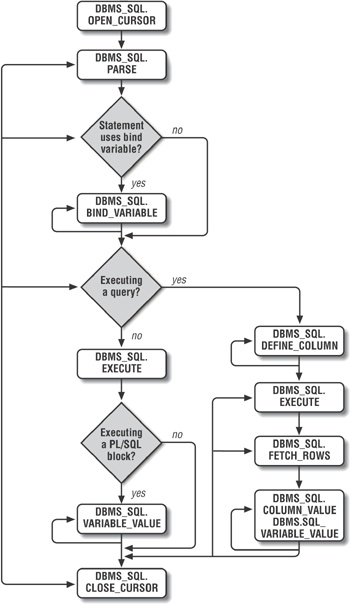Chapter 21. DBMS_SQL Built-in Package
DBMS_SQL is probably the most flexible and powerful (and potentially dangerous!) of the built-in packages. By giving you the ability to construct and execute SQL and PL/SQL statements and commands on the fly, DBMS_SQL makes a wide range of applications possible. For example, you can use the package to write your own web-based version of SQL*Plus by allowing users to enter a variety of DML and DDL commands into a browser, or you can build a self-modifying program that adds or drops PL/SQL components as they are needed. This chapter tests your understanding of this remarkably useful built-in package.
Figure 21-1 shows the flow of DBMS-SQL execution.
Beginner
21-1. | What does “dynamic SQL” mean? |
21-2. | What does “dynamic PL/SQL” mean? |
21-3. | What are the four different methods of dynamic SQL? |
21-4. | What is a “placeholder” in a dynamic SQL string? |
21-5. | What DBMS_SQL program can you use to open a dynamic cursor? |
21-6. | What DBMS_SQL program can you use to close a dynamic cursor? |
21-7. | What DBMS_SQL program can you use to parse a dynamic SQL string? |
21-8. | What DBMS_SQL programs can you use to execute a dynamic cursor? |
21-9. | What DBMS_SQL programs can you use to fetch rows from a dynamic cursor? |
21-10. | What DBMS_SQL programs can you use to extract values from columns and variables in a dynamic cursor?  Figure 21-1. DBMS_SQL execution |
21-11. | How can you include values stored in variables ... |
Get Oracle PL/SQL Programming: A Developer's Workbook now with the O’Reilly learning platform.
O’Reilly members experience books, live events, courses curated by job role, and more from O’Reilly and nearly 200 top publishers.

